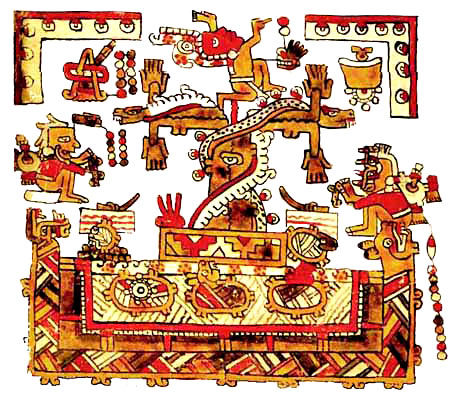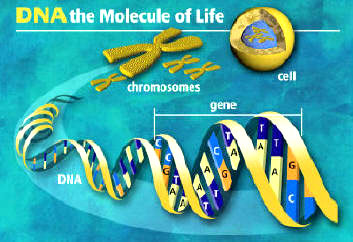|
|
|
from WorldMysteries Website
A DNA molecule consists of a ladder, formed of sugars and phosphates, and four nucleotide bases:
The genetic code is specified by the order of the nucleotide bases, and each gene possesses a unique sequence of base pairs.
Scientists use these
base sequences to locate the position of genes on chromosomes and to
construct a map of the entire human genome.
The scientific products of the HGP will comprise a resource of detailed information about the structure, organization and function of human DNA, information that constitutes the basic set of inherited "instructions" for the development and functioning of a human being. Successfully accomplishing these ambitious goals will demand the development of a variety of new technologies.
It will also necessitate advanced means of making the information widely available to scientists, physicians, and others in order that the results may be rapidly used for the public good. Improved technology for biomedical research will thus be another important product of the HGP.
From the inception of the HGP, it was clearly recognized that acquisition and use of such genetic knowledge would have momentous implications for both individuals and society and would pose a number of policy choices for public and professional deliberation.
Analysis of the ethical, legal, and social implications of genetic knowledge,
and the development of policy options for public consideration are therefore
yet another major component of the human genome research effort.
In fact, chimpanzees are more closely related to humans than orangutans and gorillas.
This unique traveler is mitochondrial DNA, and, as this provocative account illustrates, it can help scientists and archeologists piece together the history of the human race.
Find out more by
reading this book: The Seven Daughters of Eve: The Science That Reveals Our Genetic Ancestry by
Bryan Sykes.
Several years ago, spearpoints and other tools of modern man were found under a layer of volcanic ash.
When Dr. McIntyre, a member of the U.S. Geological Survey, was invited to date the overlying ash, the archaeologists thought it could be as old as 20,000 years old, pushing the arrival of man in the New World back around 5,000 years.
No one was prepared when uranium series dating and fission tracking methods provided the astounding age of 250,000 years.
Dr. McIntyre shares what happened next:
Tree of Life
Mesopotamian "Tree of Life"
Detail from Selden Codex page 2. Source: FAMSI
from WhiteHeadInstitute Website
recovered through
WayBackMachine Website
The human genome sequence is 8 times larger than all the previously sequenced genomes put together. In 1990, the Human Genome Project (HGP) began as an international collaboration propelled by the hope that global views of entire genomes would allow researchers to attack scientific problems in systematic and unbiased ways.
In its early years, the HGP produced maps of the human and mouse genomes and sequenced the genomes of yeast and nematode worm.
Now, it has produced a 94%-complete working draft of the human genome sequence, the totality of human DNA, where each letter in the draft has been read an average of 5 times. About 30% of the human genome has been sequenced with more than twice this redundancy, resulting in highly accurate "finished" sequence.
For example, the whole of chromosomes 21 and 22
have been sequenced to a finished state. No later than 2003, all the human
chromosomes will be sequenced to a finished state.
All collaborators in the project made sequence data publicly available without restriction within 24 hours.
Large blocks of
highly repetitive sequence, for example at the tips of chromosome arms and
at the centromeres (the portions of chromosomes that appear as
pinched centers when chromosomes are condensed) have been avoided, because
current technology cannot yet sequence these regions.
Genome size does not always correlate with the apparent complexity of a species because of the large amounts of repetitive sequence in many genomes. In humans the actual part of the genome that codes for proteins makes up less than 2% of the genome while repeated sequences make up at least 50% of the genome.
Repetitive sequences are thought to have no
direct functions, but they shed light on chromosome structure and dynamics.
They hold important clues about evolutionary events, help chart mutation
rates, and by seeding DNA rearrangements, they can modify genes and
create new ones. They also serve as tools for genetic studies.
A full 45% of the human genome derives from such transposons.
A major surprise of this new global analysis of the human genome is that
many components in this diverse array of repeated sequences, traditionally
considered to be "junk," appear to have played a beneficial role over the
course of human evolution.
Apparently, humans have only twice as many
genes as the fly or worm, but they have on average three times as many
kinds of proteins because of "alternative splicing," a process that can
yield different protein products from the same gene.
At least 30 different disease genes have been identified by directly using sequence produced by the HGP. In the coming years, the human genome should be sequenced to a finished state, where all gaps are closed and the sequence is at least 99.99% accurate.
Genome sequence from other species will provide crucial insights about genes and the regions that regulate their activity.
There will be a pressing need for improved methods to analyze the abundance of information being generated. And genetics will become an increasingly important part of the medical mainstream.
The pressure will grow to encourage educated use of genetic information and to set thoughtful limits on its use.
|






